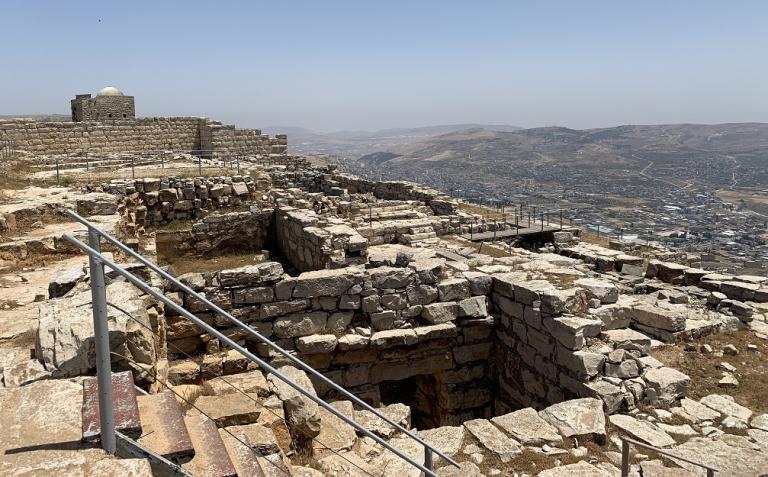
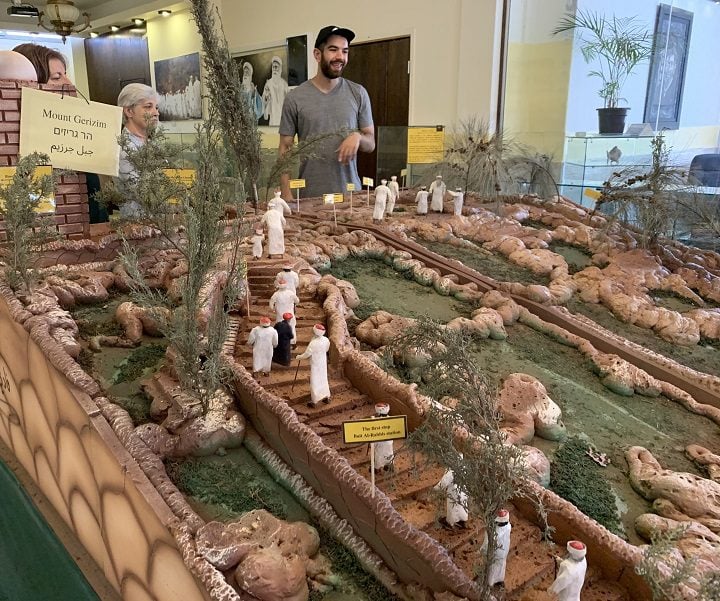
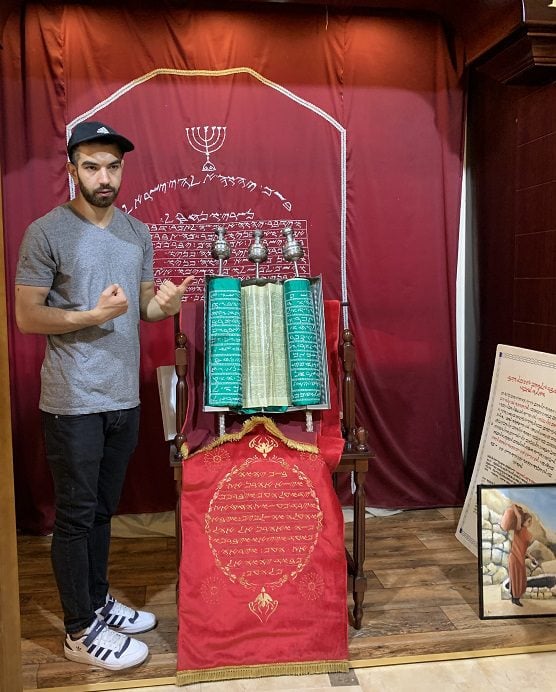
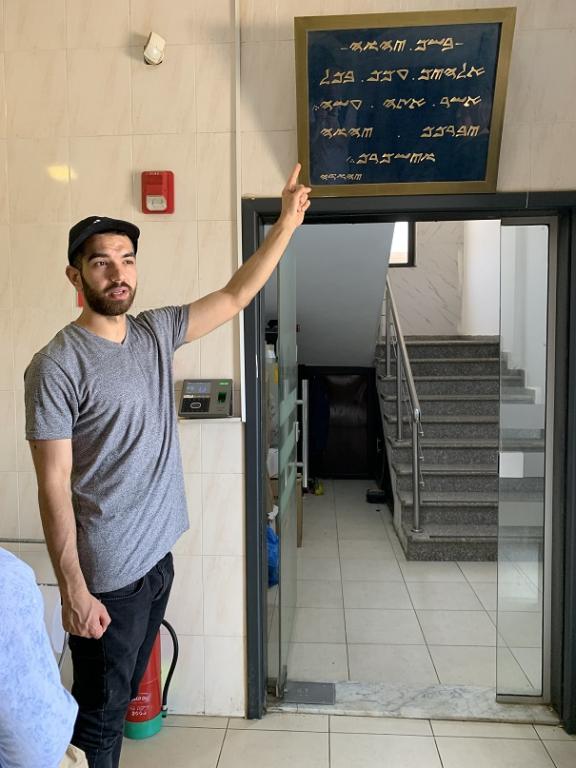
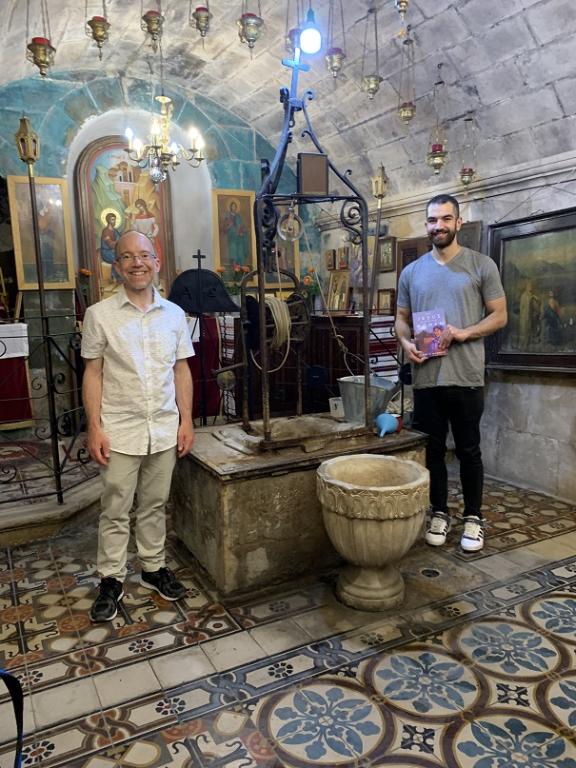
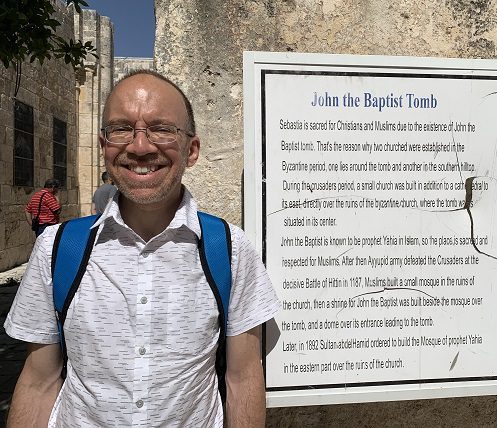
Samaritans, the world’s only holders of dual Israeli-Palestinian nationality, are a unique religious minority on the verge of extinction. In the heights of Nablus, Abdallah Cohen, the high priest’s grandson, seeks to find his own way.
The Samaritans are one of the most ancient tribes in the world - they’ve been around for over 3,000 years. But the population is now fragile and the tribe at risk of finally dying out...Their population consists of just four extended families, around only 800 people in total (in Roman times there used to be over a million). They have three men to every one woman. To keep the tribe going they’ve tried bringing in women from afar, including a number from the Ukraine. But is it too little, too late?Subscribe to see more full documentaries every week: https://bit.ly/2lneXNyTRACKS publishes unique, unexpected and untold stories from across the world every week.
From How To Save A Tribe Facebook: https://www.facebook.com/TRACKSTravel...
* * * * * *
Samaritans
Samaritans ࠔࠌࠓࠉࠌ
שומרונים
السامريونTotal population ~840 (2021)[1] Regions with significant populations Israel (Holon)
460 (2021)Total [sic] in 2021 - 840 souls[1]
Total in 2018 – 810 souls[1]
Total number on 1.1.2017 - 796 persons, 381 souls on Mount Gerizim and 415 in the State of Israel, of the 414 males and 382 females.[1]State of Palestine[a] (Kiryat Luza)
380 (2021)[1] Languages Modern spoken languages:
Israeli Hebrew, Levantine Arabic
Liturgical languages:
Samaritan Hebrew, Samaritan AramaicReligion Samaritanism Related ethnic groups Jews; other Semitic-speaking peoples (Levantine Arabs, Mandaeans, etc.)
Part of a series on Samaritanism Samaritans (/səˈmærɪtənz/; Samaritan Hebrew: ࠔࠠࠌࠝࠓࠩࠉࠌ,[3] romanized: Šā̊merīm, transl. Guardians/Keepers [of the Torah]; Hebrew: שומרונים, romanized: Šōmrōnīm; Arabic: السامريون, romanized: as-Sāmiriyyūn) are an ethnoreligious group whose traditions affirm they descend from the ancient Israelites. They are native to the Levant and adhere to Samaritanism, an Abrahamic and ethnic religion.
Samaritan tradition states that they descend from the northern Israelite tribes who were not deported by the Neo-Assyrian Empire after the destruction of the Kingdom of Israel. They believe that Samaritanism is the true religion of the ancient Israelites, preserved by those who remained in Palestine during the Babylonian captivity;[4] this belief is held in opposition to Judaism, the ethnic religion of the Jewish people, which Samaritans see as a closely related but altered and amended religion brought back by Judeans returning from Babylonian captivity. Samaritans consider Mount Gerizim (near both Nablus and biblical Shechem), and not the Temple Mount in Jerusalem, to be the holiest place on Earth.[5][6]
Once a large community, the Samaritan population shrunk significantly in the wake of the bloody suppression of the Samaritan Revolts against the Byzantine Empire (mainly in 525 CE and 555 CE). Mass conversions to Christianity under the Byzantines, and later to Islam following the Arab conquest of the Levant, also reduced their numbers significantly.[7] In the 12th century, the Jewish traveler Benjamin of Tudela estimated that only around 1,900 Samaritans remained in the regions of Palestine and Syria.[8]
As of 2022, the total Samaritan population stands at less than 1,000 people. The Samaritan community is divided between Kiryat Luza on Mount Gerizim and the Samaritan compound in Holon.[b][10] The head of the community is the Samaritan High Priest. Samaritans in Holon primarily speak Israeli Hebrew, while those in Kiryat Luza speak Levantine Arabic; for the purposes of liturgy, the languages of Samaritan Hebrew and Samaritan Aramaic are used, written in the Samaritan script. There are also a small number of Samaritans living outside the Levant, in Brazil and in Catania (Sicily), Italy. [11]
Samaritans have a standalone religious status in Israel, and there are occasional conversions from Judaism to Samaritanism and vice-versa, largely due to interfaith marriages. While Israel's rabbinic authorities came to consider Samaritanism to be a sect of Judaism,[12] the Chief Rabbinate of Israel requires Samaritans to undergo a formal conversion to Judaism in order to be officially recognized as Halakhic Jews. Rabbinic literature rejected Samaritans unless they renounced Mount Gerizim as the historical Israelite holy site.[c] Samaritans possessing only Israeli citizenship in Holon are drafted into the Israel Defense Forces, while those holding dual Israeli and Palestinian citizenship in Kiryat Luza are exempted from mandatory military service.
Samaritanism
| Samaritanism | |
|---|---|
| הדת השומרונית السامرية | |
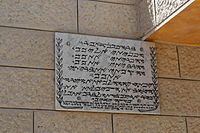 | |
| Type | Ethnic |
| Classification | Abrahamic |
| Scripture | Samaritan Torah |
| Theology | Monotheistic |
| Samaritan High Priest | Aabed-El ben Asher ben Matzliach |
| Region | Kiryat Luza, Palestine Holon, Israel |
| Language | Samaritan Hebrew, Samaritan Aramaic |
| Headquarters | Mount Gerizim |
| Separated from | Judaism, Yahwism |
| Members | c. 840 ( |
| Part of a series on |
| Samaritanism |
|---|
 |
Samaritanism is the Abrahamic, monotheistic, ethnic religion[2] of the Samaritan people, an ethnoreligious group who, alongside Jews, originate from the ancient Israelites.[3][4][5][6][7][8] Its central holy text is the Samaritan Pentateuch, which Samaritans believe is the original, unchanged version of the Torah.[9]
The Samaritan religion is internally described as the holy faith that began with Moses, unchanged over the millennia that have since passed. Samaritans believe that the Jewish Torah, and Judaism by extension, have been corrupted by time and no longer serve the duties that God mandated to the Israelites on Mount Sinai. While Jews view the Temple Mount in Jerusalem as the most sacred location in their faith, the holiest site for Samaritans is Mount Gerizim near Nablus.[10]
History
Samaritanism holds that the summit of Mount Gerizim is the true location of God's Holy Place, as opposed to the Temple Mount in Jerusalem, as defended in Judaism. As such, Samaritans trace their history as a separate entity from the Jews back to soon after the Israelites' entry into the Promised Land. Samaritan historiography traces the schism itself to High Priest Eli leaving Mount Gerizim, where stood the first Israelite altar in Canaan, and building a competing altar in nearby Shiloh. The dissenting group of Israelites who had followed Eli to Shiloh would be the ones who in later years would head south to conquer Jerusalem (the Jews), whereas the Israelites who stayed on Mount Gerizim, in Samaria, would become known as the Samaritans.[11]
Abu l-Fath, who in the 14th century wrote a major work of Samaritan history, comments on Samaritan origins as follows:[11]
Further, the Samaritan Chronicle Adler, or New Chronicle, believed to have been composed in the 18th century using earlier chronicles as sources, states:
Modern genetic studies (2004) suggest that Samaritans' lineages trace back to a common ancestor with Jews in the paternally-inherited Jewish high priesthood (Cohanim) temporally proximate to the period of the Assyrian conquest of the kingdom of Israel, and are probably descendants of the historical Israelite population,[12][13] albeit isolated given the people's reclusive history.
Conflicts between the Samaritans and the Jews were numerous between the end of the Assyrian diaspora and the Bar Kokhba revolt. Jesus' Parable of the Good Samaritan also gives evidence of conflict. The great Temple of the Samaritans, on top of Mount Gerizim, was destroyed under the orders of Jewish leader John Hyrcanus.[14]
Following the failed revolts, Mount Gerizim was rededicated with a new temple, which was ultimately again destroyed during the Samaritan revolts. Persecution of Samaritans was common in the following centuries.[citation needed]
Beliefs
The principal beliefs of Samaritanism are as follows:[15][16][17]
- There is one God, Yahweh, the same God recognized by the Jewish prophets. Faith is in the unity of the Creator which is absolute unity. It is the cause of the causes, and it fills the entire world. His nature can not be understood by human beings, but according to his actions and according to his revelation to his people and the kindness he showed them.
- The Torah is the only true holy book and was given by God to Moses. The Torah was created before the creation of the world and whoever believes in it is assured a part in the World to Come. The status of the Torah in Samaritanism as the only holy book causes Samaritans to reject the Oral Torah, Talmud, and all prophets and scriptures except for Joshua, whose book in the Samaritan community is significantly different from the Book of Joshua in the Jewish Bible. Essentially, the authority of all post-Torah sections of the Jewish Bible, and classical Jewish Rabbinical works (the Talmud, comprising the Mishnah and the Gemara) is rejected. Moses is considered to be the last of the line of prophets.
- Mount Gerizim, not Jerusalem, is the one true sanctuary chosen by God. The Samaritans do not recognize the sanctity of Jerusalem and do not recognize the Temple Mount, claiming instead that Mount Gerizim was the place where the binding of Isaac took place.
- The apocalypse, called "the day of vengeance", will be the end of days, when a figure called the Taheb (essentially the Samaritan equivalent of the Jewish Messiah) from the tribe of Joseph, will come, be a prophet like Moses for forty years and bring about the return of all the Israelites, following which the dead will be resurrected. The Taheb will then discover the tent of Moses' Tabernacle on Mount Gerizim, and will be buried next to Joseph when he dies.
Festivals and observances
The Samaritans preserve the proto-Hebraic script, conserve the institution of a High Priesthood, and the practice of slaughtering and eating lambs on Passover eve. They celebrate Pesach, Shavuot, Sukkot[18] but use a different mode from that employed in Judaism in order to determine the dates annually.[19] Yom Teru'ah (the Biblical name for "Rosh Hashanah"), at the beginning of Tishrei, is not considered a New Year as it is in Rabbinic Judaism.
Passover is particularly important in the Samaritan community, climaxing with the sacrifice of up to 40 sheep. The Counting of the Omer remains largely unchanged; however, the week before Shavuot is a unique festival celebrating the continued commitment Samaritanism has maintained since the time of Moses. Shavuot is characterized by nearly day-long services of continuous prayer, especially over the stones on Gerizim traditionally attributed to Joshua.
During Sukkot, the sukkah is built inside houses, as opposed to outdoor settings that are traditional among Jews.[20] Samaritan historian Benyamim Tsedaka traces the indoor-sukkah tradition to persecution of Samaritans during the Byzantine Empire.[20] The roof of the Samaritan sukkah is decorated with citrus fruits and the branches of palm, myrtle, and willow trees, according to the Samaritan interpretation of the four species designated in the Torah for the holiday.[20]
Religious texts
Samaritan law differs from Halakha (Rabbinic Jewish law) and other Jewish movements. The Samaritans have several groups of religious texts, which correspond to Jewish Halakha. A few examples of such texts are:
- Samaritan Pentateuch: There are some 6,000 differences between the Samaritan Pentateuch and the Masoretic Jewish Pentateuch text; and, according to one estimate, 1,900 points of agreement between it and the Greek LXX version. Several passages in the New Testament would also appear to echo a Torah textual tradition not dissimilar to that conserved in the Samaritan text. There are several theories regarding the similarities. The variations, some corroborated by readings in the Old Latin, Syriac and Ethiopian translations, attest to the antiquity of the Samaritan text,[21][22][23] although the exact date of composition is still largely unclear. Granted special attention is the so-called "Abisha Scroll", a manuscript of the Pentateuch tradition attributed to Abishua, grandson of Aaron, traditionally compiled during the Bronze Age. However, testing on the scroll revealed it was created no earlier than the 14th century CE, in fact around a century younger than the world's oldest Torah scroll.
- Historical writings
- Samaritan Chronicle, The Tolidah (Creation to the time of Abishah)
- Samaritan Chronicle, The Chronicle of Joshua (Israel during the time of divine favor) (4th century, in Arabic and Aramaic)
- Samaritan Chronicle, Adler (Israel from the time of divine disfavor until the exile)
- Hagiographical texts
- Samaritan Halakhic Text, The Hillukh (Code of Halakha, marriage, circumcision, etc.)
- Samaritan Halakhic Text, the Kitab at-Tabbah (Halakha and interpretation of some verses and chapters from the Torah, written by Abu Al Hassan 12th century CE)
- Samaritan Halakhic Text, the Kitab al-Kafi (Book of Halakha, written by Yosef Al Ascar 14th century CE)
- Al-Asatir—legendary Aramaic texts from the 11th and 12th centuries, containing:
- Haggadic Midrash, Abu'l Hasan al-Suri
- Haggadic Midrash, Memar Markah—3rd or 4th century theological treatises attributed to Hakkam Markha
- Haggadic Midrash, Pinkhas on the Taheb
- Haggadic Midrash, Molad Maseh (On the birth of Moses)
- Defter, prayer book of psalms and hymns.[24]
- Samaritan Haggadah[25]
See also
References
- ^ The Samaritan Update Retrieved 28 October 2021
"Total [sic] in 2021 - 840 souls
Total in 2018 – 810 souls
Total number on 1.1.2017 - 796 persons, 381 souls on Mount Gerizim and 415 in the State of Israel, of the 414 males and 382 females." - ^ Shulamit Sela, The Head of the Rabbanite, Karaite and Samaritan Jews: On the History of a Title, Bulletin of the School of Oriental and African Studies, University of London, Vol. 57, No. 2 (1994), pp. 255–267
- ^ Mor, Reiterer & Winkler 2010.
- ^ Coggins 1975.
- ^ Pummer 2002, pp. 42, 123, 156.
- ^ Grunbaum, M.; Geiger, Rapoport (1862). "mitgetheilten ausfsatze uber die samaritaner". Zeitschrift der Deutschen Morgenländischen Gesellschaft: ZDMG. Vol. 16. Harrassowitz. pp. 389–416.
- ^ David Noel Freedman, The Anchor Bible Dictionary, 5:941 (New York: Doubleday, 1996, c1992).
- ^ See also: Saint Epiphanius (Bishop of Constantia in Cyprus) (1 January 1987). The Panarion of Ephiphanius of Salamis: Book I (sects 1–46). BRILL. p. 30. ISBN 978-90-04-07926-7. Paul Keseling (1921). Die chronik des Eusebius in der syrischen ueberlieferung (auszug). Druck von A. Mecke. p. 184. Origen (1896). The Commentary of Origen on S. John's Gospel: The Text Rev. with a Critical Introd. & Indices. The University Press.
- ^ Tsedaka 2013.
- ^ UNESCO World Heritage Centre. "Mount Gerizim and the Samaritans". UNESCO World Heritage Centre. Retrieved 6 May 2022.
- ^ a b Anderson & Giles 2002, p. 11–12.
- ^ Shen, P; Lavi, T; Kivisild, T; Chou, V; Sengun, D; Gefel, D; Shpirer, I; Woolf, E; Hillel, J (2004). "Reconstruction of patrilineages and matrilineages of Samaritans and other Israeli populations from Y-chromosome and mitochondrial DNA sequence variation" (PDF). Human Mutation. 24 (3): 248–60. doi:10.1002/humu.20077. PMID 15300852. S2CID 1571356.
- ^ Kiaris, Hippokratis (2012). Genes, Polymorphisms and the Making of Societies: How Genetic Behavioral Traits Influence Human Cultures. Universal Publishers (published 1 April 2012). p. 21. ISBN 978-1612330938.
- ^ "Samaritan | Definition, Religion, & Bible | Britannica". www.britannica.com. Retrieved 25 May 2022.
- ^ "Religion of the Israelite Samaritans : The Root of all Abrahamic Religions".
- ^ "Religion of the Israelite Samaritans".
- ^ "Samaritan - Encyclopedia.com". www.encyclopedia.com.
- ^ Anne Katrine de Hemmer Gudme, Before the God in this Place for Good Remembrance: A Comparative Analysis of the Aramaic Votive Inscriptions from Mount Gerizim, Walter de Gruyter, 2013 ISBN 978-3-110-301878- p.52
- ^ Sylvia Powels, ‘The Samaritan Calendar and the Roots of Samaritan Chronology,' in A.D. Crown (ed.) The Samaritans, Mohr Siebeck, 1989 ISBN 978-3-161-45237-6 pp.691-741.
- ^ a b c Lieber, Dov; Luzi, Iacopo. "Inside the Samaritan high priest's fruity sukkah, literally". www.timesofisrael.com. Retrieved 5 December 2019.
- ^ James VanderKam, Peter Flint, The Meaning of the Dead Sea Scrolls: Their Significance For Understanding the Bible, Judaism, Jesus, and Christianity, A&C Black, 2nd ed. 2005 p.95.
- ^ Timothy Michael Law, When God Spoke Greek: The Septuagint and the Making of the Christian Bible, Oxford University Press, USA, 2013 p.24.
- ^ Isac Leo Seeligmann, The Septuagint Version of Isaiah and Cognate Studies,. Mohr Siebeck 2004 pp.64ff.
- ^ Samaritan Documents, Relating To Their History, Religion and Life, translated and edited by John Bowman, Pittsburgh Original Texts & Translations Series Number 2, 1977.
- ^ זבח קרבן הפסח : הגדה של פסח, נוסח שומרוני (Samaritan Haggada & Pessah Passover / Zevaḥ ḳorban ha-Pesaḥ : Hagadah shel Pesaḥ, nusaḥ Shomroni = Samaritan Haggada & Pessah Passover), Avraham Nur Tsedaḳah, Tel Aviv, 1958
Bibliography
- Anderson, Robert T.; Giles, Terry (2002). The Keepers: An Introduction to the History and Culture of the Samaritans. Hendrickson Publishing. ISBN 1-56563-519-1.
- Anderson, Robert T., Giles, Terry (2005). "Tradition kept: the literature of the Samaritans", Hendrickson Publishers.
- Bourgel Jonathan, "Brethren or Strangers Samaritans in the Eyes of Second Century ʙ ᴄ ᴇ Jews", Biblica 98/3 (2017), pp. 382–408.
- Bowman, John (1975). The Samaritan Problem. Pickwick Press.
- Coggins, R. J. (1975). Samaritans and Jews: The Origins of Samaritanism Reconsidered. Growing Points in Theology. Oxford: Basil Blackwell. ISBN 978-0-8042-0109-4.
- Crown, Alan David (2005) [1984]. A Bibliography of the Samaritans: Revised Expanded and Annotated (3rd ed.). Scarecrow Press. ISBN 0-8108-5659-X.
- Gaster, Moses (1925). The Samaritans: Their History, Doctrines and Literature. The Schweich Lectures for 1923. Oxford University Press.
- Heinsdorff, Cornel (2003). Christus, Nikodemus und die Samaritanerin bei Juvencus. Mit einem Anhang zur lateinischen Evangelienvorlage (= Untersuchungen zur antiken Literatur und Geschichte, Bd. 67), Berlin/New York. ISBN 3-11-017851-6
- Hjelm, Ingrid (2000). Samaritans and Early Judaism: A Literary Analysis. Journal for the Study of the Old Testament. Supplement Series, 303. Sheffield Academic Press. ISBN 1-84127-072-5.
- Macdonald, John (1964). The Theology of the Samaritans. New Testament Library. London: SCM Press.
- Montgomery, James Alan (2006) [1907]. The Samaritans, the Earliest Jewish Sect. The Bohlen Lectures for 1906. Eugene, Oregon: Wipf & Stock. ISBN 1-59752-965-6.
- Mor, Menachem; Reiterer, Friedrich V.; Winkler, Waltraud, eds. (2010). Samaritans: Past and Present: Current Studies. Studia Samaritana, 5 & Studia Judaica, 53. Berlin: De Gruyter. ISBN 978-3-11-019497-5.
- Pummer, Reinhard (1987). The Samaritans. Leiden: E. J. Brill. ISBN 90-04-07891-6.
- Pummer, Reinhard (2002). Early Christian Authors on Samaritans and Samaritanism: Texts, Translations and Commentary. Mohr Siebeck. ISBN 978-3-16-147831-4.
- Purvis, James D. (1968). The Samaritan Pentateuch and the Origin of the Samaritan Sect. Harvard Semitic Monographs. Vol. 2. Cambridge, Massachusetts: Harvard University Press.
- Thomson, J. E. H. (1919). Tha Samaritans: Their Testimony to the Religion of Israel. Edinburgh & London: Oliver and Boyd.
- Tsedaka, Benyamim (2013). The Israelite Samaritan Version of the Torah. ISBN 9780802865199.
- Zertal, Adam (1989). "The Wedge-Shaped Decorated Bowl and the Origin of the Samaritans". Bulletin of the American Schools of Oriental Research, No. 276. (November 1989), pp. 77–84.







No comments:
Post a Comment